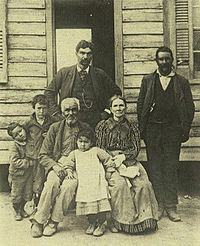
Members of the Nansemond tribe, c. 1900.
The Nansemond have been recognized as a Native American tribe by the Commonwealth of Virginia, along with ten other Virginia Indian tribes. They are not federally recognized but are one of six Virginia tribes without reservations that are included in a bill for federal recognition under consideration by the United States Congress.
Most members of the tribe live in the Suffolk/Chesapeake, Virginia area. At the time of European encounter, the historic Nansemond tribe spoke one of the Algonquian languages.
The Nansemond were members of the Powhatan chiefdom. They lived along the Nansemond River, an area they called Chuckatuck. In 1607, when English people arrived to settle at Jamestown, the Nansemond were initially wary.
In 1608, the English raided one of the Nansemond towns, burning houses and destroying canoes to force the people to give corn to the settlers. Captain John Smith and his men demanded 400 bushels of corn or threatened to destroy the village, remaining canoes, and houses. The tribe agreed, and Smith and his men left with most of the tribe's corn supply. They returned the following month for the rest, which left the tribe in bad shape for the winter. Relations between the English and the Nansemond deteriorated further in 1609 when the English tried to gain control of Dumpling Island, where the head chief lived and where the tribe's temples and sacred items were kept. The English destroyed the burial sites of tribal leaders and temples. Houses and religious sites were ransacked for valuables, such as pearls and copper ornaments, that were buried with the bodies of leaders. By the 1630s, the English began to move into Nansemond lands, with mixed reactions.
John Basse, an early settler in Virginia, married Elizabeth, the daughter of the King of the Nansemond Nation in Holy Baptism and in Holy Matrimony August 14, 1638. Basse was born 7 September 1616; died 1699.
They had 8 children (Elizabeth; John; Jordan; Keziah; Nathaniel; Richard; Samuel; William). They are related to the Coppedge/Coppage/Coppidge Family.
Some Nansemond claim descent from this marriage. Based on her research, Dr. Helen C. Rountree says that all current Nansemond descend from this marriage, making the tribe a family affair.
The photo above shows members of the Weaver and Bass families, ca. 1900:
"William H. Weaver is sitting; Augustus Bass is standing behind him. The Weaver family were indentured East Indians (from modern-day India and Pakistan) who were free in Lancaster County by about 1710. By 1732 they were "taxables" [note: free blacks and Indians had to pay a tax in Virginia and North Carolina] in Norfolk County and taxable "Mulatto" landowners in nearby Hertford County, North Carolina by 1741.
The Nansemond were affected by English colonial pressures in the 17th century and split apart. Those who were Christian and had adopted more English customs stayed along the Nansemond River as farmers. "The other Nansemonds warred with the English in 1644, fled southwest to the Nottoway River, and had a reservation assigned them there by the Virginia colony. By 1744 they had ceased using the reservation and gone to live with the Nottoway Indians [note: this was an Iroquoian-language tribe] on another reservation nearby... The Nansemond sold their reservation in 1792 and were known as "citizen" Indians.
Today, the Nansemond have about 200 tribal members. As a "citizen tribe", they gained recognition by Virginia in 1984. The disruption of wars and loss of records in Virginia would make it difficult for them to provide the extensive documentation needed for federal recognition. The current Chief is Barry "Big Buck" Bass. The Nansemond are one of the few state-recognized tribes in Virginia that have not purchased land for their tribe. But, they are trying to get the city of Suffolk to give up 100 acres (0.40 km2) of an 1,100-acre (4.5 km2) riverfront park. They want to use this land to reconstruct Mattanock, a town of their ancestors. They plan to attract tourists by demonstrating their heritage. The tribe has enlisted the help of Helen C. Rountree, whose research helped identify Mattanock Town's location. The village would utilize archaeological and other research to assure the proper dimensions of longhouses to be built on the site..
In August 2013 the City of Suffolk transferred Nansemond ancestral lands back to the tribe. In November 2013 members of the Nansemond Tribe gathered at the site of Mattanock Town and blessed the land.*
MEN
Kin 55: Blue Electric Eagle
I activate in order to create
Bonding mind
I seal the output of vision
With the electric tone of service
I am guided by the power of self-generation
I am a polar kin.
I establish the blue galactic spectrum.
The superhuman is endowed with cosmic consciousness to know that it is an androgynous ever-evolving interval of expansive cosmic enlightenment.*
*Star Traveler's 13 Moon Almanac of Synchronicity, Galactic Research Institute, Law of Time Press, Ashland, Oregon, 2016-2017,
The Sacred Tzolk'in
Manipura Chakra (Limi Plasma)




No comments:
Post a Comment